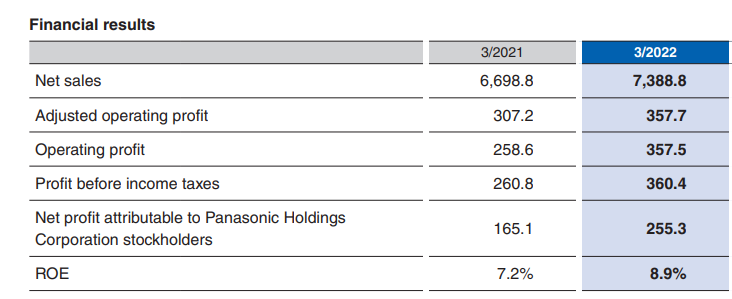Before we dive deep into the SWOT analysis, let’s get the business overview of Panasonic. Panasonic Corporation is a global technology company based in Japan. Panasonic has diversified operations across a wide range of business segments. Below are some of the primary segments and their respective focuses:
- Appliances: This segment includes home appliances, beauty, and health-related electronics products. Items include refrigerators, washing machines, vacuum cleaners, televisions, air conditioners, personal care products, and more.
- Automotive: In collaboration with various automobile manufacturers, Panasonic provides infotainment systems, batteries for electric vehicles (notably a key supplier for Tesla), and other automotive-related electronic components.
- Industrial Solutions: This segment offers a wide range of products, from electronic components and devices to factory automation systems, contributing to the progress of industries worldwide.
- Connected Solutions: This segment includes onboard aircraft in-flight entertainment systems, point-of-sale systems, video-related products, surveillance cameras, and more.
- Life Solutions: Provides wiring devices, solar power generation systems, ventilation and air conditioning systems, and lighting fixtures.
- Lumix and Imaging: This segment offers digital cameras and other imaging-related devices.
- Home Entertainment: Includes high-quality TVs, audio equipment, Blu-ray disc players, and more.
Besides these, Panasonic has various other ventures, including some into new technologies like smart homes, renewable energy, and more. The company has always focused on innovative technology to improve the quality of life of consumers and society at large.

Here is the SWOT analysis of Panasonic
A SWOT analysis is a strategic planning tool used to evaluate the Strengths, Weaknesses, Opportunities, and Threats of a business, project, or individual. It involves identifying the internal and external factors that can affect a venture’s success or failure and analyzing them to develop a strategic plan. In this article, we do a SWOT Analysis of Panasonic.
SWOT Analysis: Meaning, Importance, and Examples
Strengths
- Broad Product Portfolio: Panasonic’s wide range of products covers numerous segments, including home appliances, automotive electronics, industrial solutions, and consumer electronics. This diversification mitigates the risk associated with the failure of a single product or segment.
- Strong R&D Capabilities: Panasonic has a strong focus on Research, and Development enables them to innovate and stay competitive constantly. It also allows the company to introduce cutting-edge technologies across its product range.
- Global Presence: Panasonic has a well-established presence in various global markets. This broad geographic footprint allows the company to reach a large customer base and gain diverse revenue streams.
- Strong Brand: Panasonic enjoys a strong brand reputation and is recognized for its product quality and reliability. This strong brand image drives customer loyalty and attracts new customers.
- Strategic Partnerships: Panasonic has established strategic partnerships with various companies, notably its collaboration with Tesla to produce electric vehicle batteries. Such partnerships allow the company to broaden its reach and tap into new markets.
- Experience and History: Having been established in 1918, Panasonic has a long history and extensive experience in the electronics industry. This provides a wealth of expertise, relationships, and a deep understanding of various markets.
- Sustainable and Environmentally Conscious: Panasonic has committed itself to sustainability, with various products designed to be energy-efficient and environmentally friendly. This commitment to sustainability appeals to a growing demographic of environmentally-conscious consumers and businesses.
- Strong Supply Chain Management: Panasonic’s efficient supply chain allows for cost-effective production and distribution of its products, contributing to the company’s competitive pricing strategy.
Weaknesses
- Heavy Dependence on the Japanese Market: Despite its international presence, a significant portion (~40%) of Panasonic’s revenue comes from its home market, Japan. This reliance can expose the company to regional economic risks and potential stagnation, given the mature nature of the Japanese market.
- Competition: Panasonic operates in highly competitive markets. Companies like Samsung, Sony, LG, and other global tech giants often outpace Panasonic in certain product categories, which can impact Panasonic’s market share and profitability.
- Weak Performance in the Smartphone Market: Panasonic’s ventures into the smartphone market have not been as successful as some competitors. Given the size and growth of the global smartphone market, this can be seen as a missed opportunity.
- Operating Cost Structure: Compared to some competitors, Panasonic sometimes struggles with higher operational costs, which can impact its profitability. These costs can be related to labor, production, or the extensive R&D required for its broad product portfolio.
- Product Recall Issues: Like many manufacturers, Panasonic has had to recall products due to defects or safety issues, which can damage the brand’s reputation and incur substantial costs.
- Less Successful in Certain Consumer Electronics Segments: Despite its wide product range, Panasonic has not been as successful in certain consumer electronics segments as some competitors, including televisions and home entertainment systems.
- Slow to Adapt to Market Changes: Some critics argue that Panasonic has been slower than some competitors in responding to market trends, such as the shift toward mobile devices and the growing demand for smart home products.
Opportunities
- Growing Demand for Electric Vehicles (EVs): With Panasonic being one of the leading providers of batteries for electric vehicles (notably Tesla), the expected boom in the EV market over the next decade represents a significant growth opportunity.
- Smart Homes and IoT: The trend toward smart homes and the broader Internet of Things (IoT) presents a major opportunity for Panasonic to expand its product offerings in these areas. This could include everything from connected appliances to home security systems.
- Healthcare Technology: Panasonic can leverage its technology expertise to expand further into healthcare technologies, a sector expected to grow significantly. This could include telemedicine technologies, healthcare devices, and other medical equipment.
- Renewable Energy: As the world continues to move towards cleaner, renewable energy sources, there’s a significant opportunity for Panasonic’s eco-friendly and energy-efficient solutions, such as solar panels and energy storage systems.
- Expansion in Emerging Markets: Emerging markets like India, China, Africa, and Southeast Asia have growing middle-class populations with increasing purchasing power. Panasonic can capitalize on this trend by expanding its operations and tailor its product offerings to these markets.
- Artificial Intelligence and Robotics: AI and robotics are areas of rapid growth. Panasonic could leverage these technologies to innovate across its existing product lines and potentially open up entirely new business segments.
- Strategic Partnerships and Acquisitions: Panasonic can seek new strategic partnerships or acquisitions to boost its technological capabilities, expand into new markets, or gain access to new customer bases.
Threats
- Intense Competition: Panasonic operates in a highly competitive market, with strong rivals such as Sony, Samsung, and LG in the consumer electronics space. With their massive R&D capabilities and extensive resources, these competitors can pose a significant challenge to Panasonic’s market share and profitability.
- Technological Disruption: The pace of technological change in Panasonic’s industry is extremely high. If Panasonic fails to keep up with these changes or misses a crucial technological shift, its market position could erode.
- Global Economic Conditions: Unfavorable economic conditions, such as a recession or trade war, could reduce consumer spending and affect Panasonic’s sales. Similarly, fluctuations in exchange rates can impact the company’s financial performance.
- Regulatory Changes: Changes in international, national, or local regulations can impact various aspects of Panasonic’s operations, from production to sales to environmental compliance. For example, stricter regulations around e-waste disposal or battery production could increase costs for the company.
- Supply Chain Disruptions: Disruptions in the supply chain due to natural disasters, geopolitical issues, or global health crises could affect Panasonic’s ability to manufacture and deliver products.
- Cybersecurity Threats: Panasonic is susceptible to cybersecurity threats like any large corporation. A significant breach could lead to considerable financial and reputational damage.
- A shift in Consumer Preferences: A swift change in consumer tastes or a shift towards other brands could affect the demand for Panasonic’s products. The rise of local brands in emerging markets can also pose a threat.











